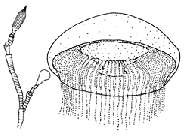
| Intro | | Search taxa | | Browse taxa | | Distributions | | Terminology | | References | | Statistics | | Online sources | | Tutorial | | Log in |
WoRMS taxon detailsAequoreidae Eschscholtz, 1829
13553 (urn:lsid:marinespecies.org:taxname:13553)
accepted
Family
Aequoridae Eschscholtz, 1829 · unaccepted > misspelling - incorrect subsequent spelling (spelling variant)
Polycannidae Haeckel, 1879 · unaccepted (synonym)
Zygocannidae Haeckel, 1879 · unaccepted (synonym)
marine,
Eschscholtz, F. (1829). System der Acalephen. Eine ausführliche Beschreibung aller medusenartigen Strahltiere. Ferdinand Dümmler, Berlin, pp. 1-190, 116 pls., available online at https://www.biodiversitylibrary.org/page/10665047
page(s): 108 [details]
Schuchert, P.; Choong, H.; Galea, H.; Hoeksema, B.; Lindsay, D.; Manko, M.; Pica, D. (2025). World Hydrozoa Database. Aequoreidae Eschscholtz, 1829. Accessed through: World Register of Marine Species at: https://www.marinespecies.org/aphia.php?p=taxdetails&id=13553 on 2025-07-15
Date action by 2004-12-21 15:54:05Z created db_admin
Nomenclatureoriginal description
Eschscholtz, F. (1829). System der Acalephen. Eine ausführliche Beschreibung aller medusenartigen Strahltiere. Ferdinand Dümmler, Berlin, pp. 1-190, 116 pls., available online at https://www.biodiversitylibrary.org/page/10665047 page(s): 108 [details] original description (of Zygocannidae Haeckel, 1879) Haeckel, E. (1879). Das System der Medusen. Erster Teil einer Monographie der Medusen. <em>Denkschriften der Medicinisch-Naturwissenschaftlichen Gesellschaft zu Jena.</em> 1: XX+1-360, 320 plates., available online at https://www.biodiversitylibrary.org/page/32605578 page(s): 214 [details] original description (of Polycannidae Haeckel, 1879) Haeckel, E. (1879). Das System der Medusen. Erster Teil einer Monographie der Medusen. <em>Denkschriften der Medicinisch-Naturwissenschaftlichen Gesellschaft zu Jena.</em> 1: XX+1-360, 320 plates., available online at https://www.biodiversitylibrary.org/page/32605578 [details] Other Present Present  Inaccurate Inaccurate  Introduced: alien Introduced: alien  Containing type locality Containing type locality
From editor or global species database
Diagnosis Very large hydromedusa with wide, circular manubrium; usually no gastric peduncle; numerous simple or branched radial canals; gonads on radial canals, separated from manubrium; marginal tentacles hollow; usually with excretory pores or papillae on bulbs; no marginal or lateral cirri; statocysts closed; no ocelli. Hydroid colony stolonal or sparingly branched; hydrotheca delicate, tubular, elongated, radially symmetrical, operculum a continuation of hydrothecal wall, composed of several long, triangular flaps, not delimited by crease-line; in older colonies operculum generally lost and hydrotheca reduced to a perisarcal collar; hydranth with intertentacular web, tentacles amphicoronate, moniliform-like when completely extended; gonotheca large, pedicellate, cylindrical, giving rise to one or two medusae. [details] Spelling Original spelling was Aequoridae [details]
|

